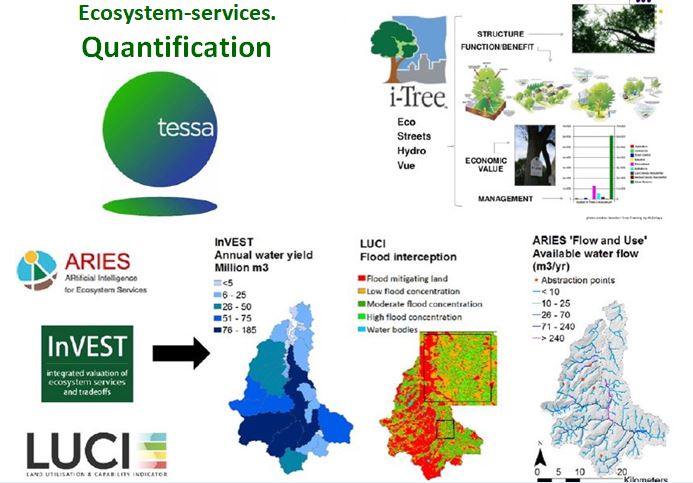From conventional public gardening to green infrastructure management
Blog Detail Page
The European Union defines Green Infrastructure (GI) as a "strategically planned network of high-quality natural and semi-natural areas, designed and managed to provide the greatest amount of ecosystem services and protect biodiversity, both in rural and urban settlements". The GI is an integrating tool for Nature-Based Solutions, whose main objective is the protection of natural capital. This novel approach aims to provide environmental services that contribute to protecting human health and well-being, as well as fighting against the effects of climate change (biodiversity protection, air and water quality improvement, adaptation and resilience to extreme-weather events, etc.)

Figure 1. Elements of a Green Infrastructure network. On the left side of the graphic above you see an image that calls out each of the five areas that Green Infrastructure has an impact on in any municipality. On the right side you see a numbered list of the GI elements. (Source: Municipal Green Infrastructure Management Guide)
To get from conventional public gardening to GI management, a change in the conception, objectives, regulatory framework and mentality of all the agents involved in its management is necessary. As opposed to the purely ornamental approach that characterizes conventional public gardening, GI management values, among others, the increase in biodiversity, the improvement of air quality, the improvement of health, the proximity to nature and greater social cohesion. Consequently, GI management involves a change in governance and in its budget allocation, based on a fair and proportionate system connected to the environmental reality, continuously assessed through ecosystem-services indicators.
Ecosystem-services indicators
Management based on ecosystem services aims at different goals. Listed below are those related to climate change mitigation and adaptation:
- Conserve and increase urban biodiversity. Plan and management of beneficial species.
- Improve resilience to extreme weather events (droughts, floods, heat waves, etc.), reducing risks associated with the lack of adaptation to the environment.
- Minimize the heat island effect and improve the thermal regulation of the municipalities.
- Improve air quality: Vegetation reduces atmospheric pollutants and provides oxygen and fixing CO2.
- Improve soil and water quality: Increase in water retention capacity, decrease of surface runoff and flood risk and improvement of urban drainage systems.
- Improve the health of citizens, planning the use of suitable plant species and avoiding allergenic or harmful species.
- Facilitate the transition towards sustainable mobility: Construction and maintenance of pedestrian and bicycle infrastructures.
It is necessary to set environmental indicators, which allow the calculation of each ecosystem service, through different tools. Each indicator is assigned a percentage of total ecosystem services, thereby allocating the corresponding resources to minimize negative impacts and maximize benefits.

Figure 2. Computer tools for calculating ecosystem services. The figure above shows various software tools used in the calculation of the necessary KPIs for efficient Green Infrastructure management. (Source: Municipal Green Infrastructure Management Guide)
The value of each of the indicators serves as the basis for the preparation of the municipality’s GI Strategic Plan. As a result, a shift between the current municipal budget for the conservation of green areas to a new allocation according to the value of ecosystem services is achieved. The goal adjustment when managing a municipality’s GI is the basis for a successful model change.
Implementation key aspects
The right implementation of GI management systems requires adapting municipal organizational structures in order for all involved agents to participate in the decision-making and assigning the corresponding budget items. The GI Strategic Plan is the basis on which all actions related to GI management relay and must include an impact assessment that serves as the starting point for planning with quality objectives.
Regarding financing, there is a clear trend towards an increase in GI both in terms of quantity and quality. The need for proper management entails an increase in means and resources. Therefore, it is necessary to analyze all possible financing alternatives, including public-private collaboration through, for instance, service concession or services with investment contracts.
Further information is available (Spanish only) the Green Infrastructure Guide and the Municipal Green Infrastructure Management Guide.
